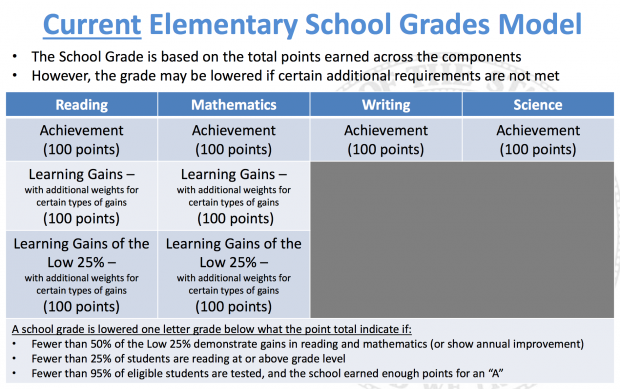Explaining The Proposed Changes To Florida’s School Grading Formula

marsmet tallahassee
Education Commissioner Pam Stewart has recommended changes to the school grading formula.
Florida’s school grades would focus on student performance on state tests, graduation rates and earning college credit or industry certifications, according to a proposal posted at the Florida Department of Education website.
Florida’s school grades were intended to be an easy-to-understand way for parents to know how their child’s school is performing. But educators have complained the formula has gotten too complicated as state officials added more and more components to the formula.
School grades are important because good grades determine which schools and teachers are paid bonuses, while low-performing schools must come up with a plan to improve their grade or even be closed. High-performing schools can even raise nearby property values.
With Florida moving to new K-12 math and language arts standards and a new statewide test next year, Education Commissioner Pam Stewart wants to simplify things a little.
The proposal trims the number of components that make up the school grade score.
The formula now focuses on four factors:
Achievement — The percentage of students meeting state targets on standardized tests.
Learning gains — Schools are rated on whether students performing below grade level on state tests are improving toward grade level and whether students scoring at grade level continue to improve beyond grade level.
Graduation — Schools would earn points based on their graduation rate.
College credit or industry certifications — Lawmakers have put an emphasis on making sure high school graduates are ready for college-level work or a job.
The formula would maintain an emphasis on the lowest-performing 25 percent of students.
Stewart would also do away with bonuses and penalties which could affect the grades.
Those penalties can mean two schools could have different grades despite receiving the same number of points on the scoring scale. For instance, school lose a letter grade if fewer than 25 percent of students are reading at grade level.
Stewart also wants to translate the grades into a percentage rather than a point score. A school earning 90 percent of the total points available, say, would earn an A. Those percentages could be adjusted as overall school performance changes.
While the goal is to simplify the formula, Stewart’s proposal doesn’t change the number of factors comprising each grade all that much.
Elementary school grades are now based on eight components in four categories:
The new grades would be based on seven components in three categories:
The middle school formula would go from nine components in five categories:
To eight components in four categories:
Finally, high schools now have a dozen components in eight categories:
Which would shrink to 10 components in six categories:
State superintendents have asked for a broader overhaul, eliminating the school grades entirely in favor of a new system which could include attendance, discipline and other factors.
The State Board of Education will discuss the proposal in Orlando on Tuesday. You can read the proposal here.







